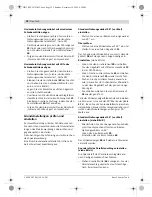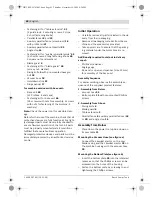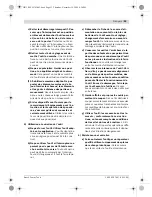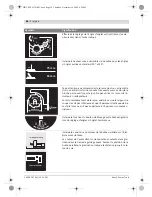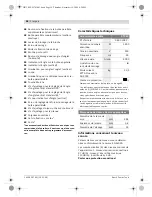
44
| English
1 609 929 T49 | (19.11.09)
Bosch Power Tools
Mounting the Parallel Guide
(see figures g1–g3)
The parallel guide
8
can be positioned either left
or right from the saw blade.
– Screw the clamping knob
46
into the thread
intended for this purpose at the front of the
parallel fence.
– Firstly, place the parallel fence onto the rear
of the saw table. Now, position the parallel
fence in guide groove
15
.
The parallel fence can now be moved to any
position.
– To lock the parallel guide, press the clamping
knob
46
down.
When sawing narrow workpieces and for bevel
cuts
, the auxiliary parallel fence (aluminium)
18
must be mounted to parallel fence
8
.
In this case, the auxiliary parallel fence (plastic)
49
can be mounted to the angle stop.
– Insert the profile rail
47
into the groove on
the short side of the auxiliary parallel fence
18
.
– Position the profile rail
8
in front of the par-
allel fence in such a manner that the holes of
both parts are in alignment.
– Insert the fastening knobs
48
through the lat-
eral holes in the parallel fence and tighten
them.
When sawing high, narrow workpieces
, the
auxiliary parallel fence (aluminium)
18
must be
mounted directly to parallel fence
8
.
– Fasten the auxiliary parallel fence
18
with the
2 square nuts from fastening kit
45
and the
fastening knobs
48
directly to the parallel
fence
8
.
Dust/Chip Extraction
Dusts from materials such as lead-containing
coatings, some wood types, minerals and metal
can be harmful to one’s health. Touching or
breathing-in the dusts can cause allergic reac-
tions and/or lead to respiratory infections of the
user or bystanders.
Certain dusts, such as oak or beech dust, are
considered as carcinogenic, especially in con-
nection with wood-treatment additives (chro-
mate, wood preservative). Materials containing
asbestos may only be worked by specialists.
– Use dust extraction whenever possible.
– Provide for good ventilation of the working
place.
– It is recommended to wear a P2 filter-class
respirator.
Observe the relevant regulations in your country
for the materials to be worked.
The dust/chip extraction can be blocked by
dust, chips or workpiece fragments.
– Switch the machine off and pull the mains
plug from the socket outlet.
– Wait until the saw blade has come to a com-
plete stop.
– Determine the cause of the blockage and cor-
rect it.
External Dust Extraction (see figure h)
– Connect a vacuum hose to the sawdust ejec-
tor
32
.
– Additionally, a dust extraction system can be
connected to vacuum connection
5
to in-
crease the extraction performance.
For this, remove the cap from the vacuum
connection.
The vacuum cleaner must be suitable for the ma-
terial being worked.
When vacuuming dry dust that is especially det-
rimental to health or carcinogenic, use a special
vacuum cleaner.
OBJ_BUCH-783-003.book Page 44 Thursday, November 19, 2009 4:24 PM



